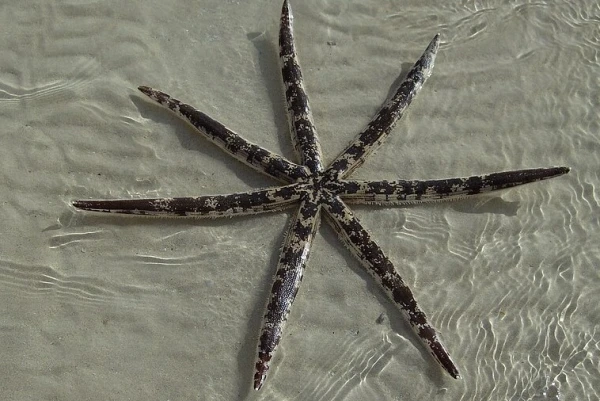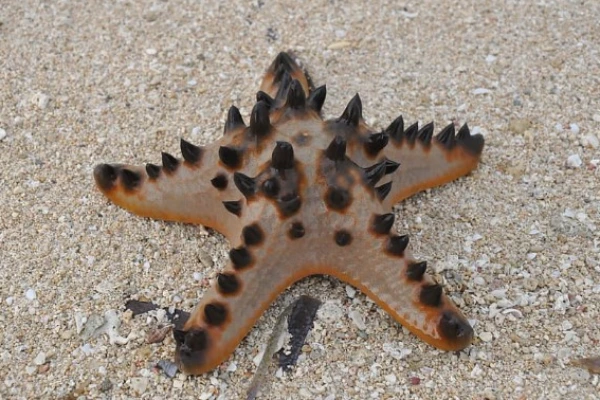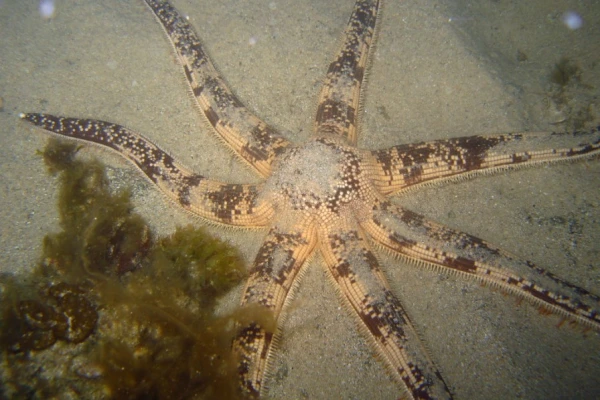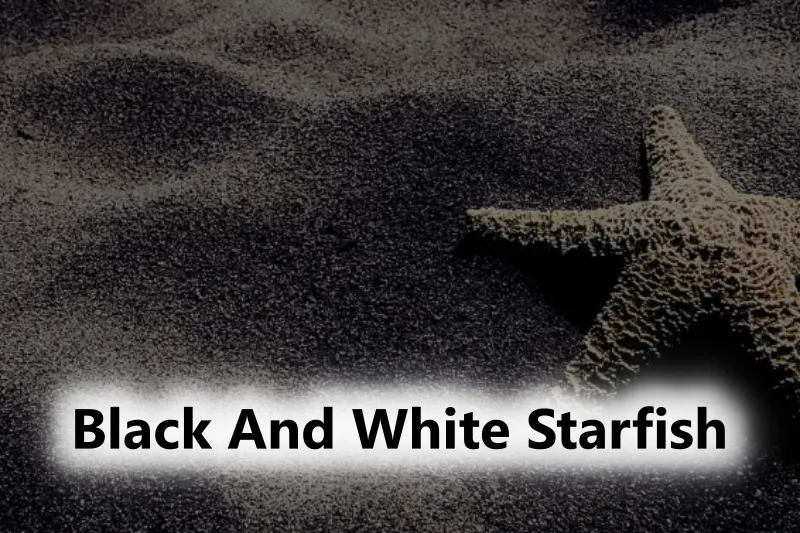Sea stars, also known as starfish, are star-shaped marine invertebrates belonging to the phylum Echinodermata. They are related to other echinoderms like brittle stars, sea urchins, and sea lilies.
They have complex life cycles and can reproduce sexually and asexually. The Asteroidea occupy significant ecological roles, with species like the ochre sea star and reef sea star being keystone species in ecology. The fossil record for starfish is ancient, dating back to the Ordovician around 450 million years ago.
Sea stars have a central disc and commonly have five arms, with their aboral surfaces varying in color and having overlapping plates. They are opportunistic feeders and predators of benthic invertebrates with specialized feeding behaviors.
Have you ever encountered any black and white starfish or sea stars? You might find a lot of articles related to colorful sea stars that forget about these stunning black and white sea stars or starfish. And today we are going to look at some beautiful and amazing black and white starfish or sea stars.
Are Black And White Starfish Or Sea Stars Dangerous?
This answer may surprise you. No, the black and white starfish are not dangerous. Sea star species, such as the Crown of Thorns and Sunstar, can be venomous to humans. But they are not proper black and white starfish.
If we talk about the black and white starfish, in reality, are they venomous or not? So let us tell you that they are not venomous to any creatures.
The spikes on chocolate chip starfish may make you fear in your mind that these spikes may have poison, but they aren’t. These small species of starfish are friendly with humans. They aren’t dangerous; if you saw them on the beach and came into contact with them, then you don’t need to worry, because they don’t attack humans.
What Do Black And White Starfish Eat?
Like other starfish, the black and white starfish also eat different kinds of creatures present in the ocean. As they rest on the bed of the ocean, they eat microalgae, sponges, bivalves, snails, and other small creatures in the sea.
If we talk about particularly what they eat, then taking that into account, eight-arm Lucida eats other sea stars, heart urchins, and sea cucumber. These are some of the things Eight Arm Lucida likes to eat.
Various species can absorb organic nutrients from the surrounding water, making it a significant portion of their diet.
Are There Any Black And White Starfish?
Yes, there are beautiful black and white starfish and sea stars in the deep blue ocean. And these starfish are so stunning and cute that you will admire their beauty. Here, we are going to encounter six black and white starfish in the world. These starfish species’ names are:
- Eight-armed Lucida
- Chocolate chip starfish
- Serpent-brittle starfish
- Southern sand star
- Sand sifting starfish
- Cake Sea Star
1. Eight armed Lucida Starfish

| Scientific name | Luidia maculata |
| Location | Indian and Pacific Ocean |
| Identification | flat upper surface with a star pattern |
Luidia maculata is a large starfish with seven or eight-pointed arms and a small central disc. It has a flat upper surface with granulations and flat-topped structures called paxillae. The underside is pale, and large tube feet with pointed tips emerge from grooves along the arms.
The color forms of this starfish can be uniform in blackish grey, dark brown or greenish-brown, dark brown with orange-brown chevron-shaped markings, or light brown with dark markings. The upper side has variable colors and patterns, with a darker or black star-shaped pattern in the center.
2. Chocolate chip starfish

| Scientific name | Protoreaster nodosus |
| Location | Indo-pacific ocean |
| Identification | Spikes at the upper top and arms |
P. nodosus sea stars are a fascinating species with rows of spines, or “horns,” arranged in a single row on the dorsal side, used to scare predators.
They are typically five-pointed star-shapes with tapering arms, with some anomalies like four or six-armed specimens. The sea stars are usually colored in shades of red or brown but can be light tan, giving them a bumpy, bumpy, cookie-like appearance.
The central disk can reach a diameter of 12 cm, while the arms measure about 14 cm. The whole body can reach up to 40 cm, with adult specimens between 20 and 25 cm (8 and 10 inches) in diameter.
The Chocolate Chip Starfish has short and thick arms with shades of white, yellow, brown, or light tan, red, blue, and orange. The chocolate chips or knobs are variable in size, color, and pattern between specimens, typically dark brown.
3. Serpent Brittle starfish
| Scientific name | Ophiuroidea sp. |
| Location | Caribbean, Eastern Asia, Fiji, Africa, and Australia |
| Identification | banded stripes at arms |
Ophiuroidea sp. have a five-segment radial body symmetry, similar to starfish. They have five long, flexible arms connected to a central body disk and a mouth with five toothed jaws made of skeletal plates.
Adult serpent starfish grow up to 6–8 inches (15–20 cm) and others over 20 inches. They have a calcitic skeleton composed of ossicles, which form armor plates covered by an outer skin or epidermis.
4. Southern sand star

| Scientific name | Luidia australiae |
| Location | Southern Australia and New Zealand |
| Identification | irregularly blotched arms |
Luidia australiae is a species of sea snail with seven long, slim, tapering arms and a pale or dull yellow central disc. This species of starfish is identified by its irregularly blotched arms.
It is native to southern Australia and New Zealand, found on reefs and seagrass meadows, and semi-buried in sand at depths of up to 110 meters. It can grow up to 40 centimeters in diameter.
5. Sand sifting starfish
| Scientific name | Astropecten polyacanthus |
| Location | Indo-pacific and southern Atlantic ocean |
| Identification | long, sharp marginal spines at the edge of arms |
Astropecten polyacanthus, also known as the sand-sifting starfish or comb sea star, is a sea star species found in the Indo-Pacific region and the southeastern part of the Atlantic Ocean.
Its arms spread up to 20 cm (8 in) and are covered with thick spines. Along the edges of the five arms is a fringe of long, sharp marginal spines. The arms are fairly broad and have a maximum length of 9 centimeters (3.5 in).
Astropecten polyacanthus is not confused with Archaster spp., which has similar features to Astropecten polyacanthus, but Archaster has flat and blunt spines and parallel, radial rows of plates on its upper surface.
6. Cake Sea Star
| Scientific name | Anthenea aspera |
| Location | North Australia, southern Japan, China, Indonesia, and Singapore |
| Identification | large marginal plates around the edges |
This species has a large, flat sea star with a diameter of 10–20 cm, with arms with rounded tips and large marginal plates around the edges. It comes in various colors and patterns.
It can be seen in black, white, brown, red, orange, yellow, and even green. Found on the northern shores. Smaller ones are found in seagrass meadows, while larger ones are found on coral rubble.
These sea stars are considered rare in the Indo-Pacific, only known from North Australia, southern Japan, China, Indonesia, and Singapore. They are found on muddy sand in Australia. The star is more active at night.
Black and White Starfish Predators
Looking forward now, as we find these beautiful starfish or sea stars, There are some enemies of theirs who are eating them. Here, we are going to look at some of the black and white starfish predators.
As we all know, every organism on this earth lives after killing another. It is the cycle of nature that sustains life on earth. and these predators eat starfish to sustain themselves on Earth.
1. Alaska King Crabs
King crabs, found on Alaska’s coast, prey on starfish for an easy meal. Starfish have a hard exoskeleton and lack meat, making them unnutritious.
However, king crabs are not picky eaters and will consume various sea creatures, including starfish, worms, and other crabs. They prefer to tear apart the starfish before eating.
2. Common Octopuses
The giant octopus, the largest species in the Pacific Ocean, feeds on starfish, typically killing them before eating them, potentially eating up to five in a single day.
3. Leatherback Sea Turtle
The leatherback sea turtle, the world’s largest, inhabits the Pacific, Atlantic, and Indian oceans, consuming starfish through biting and flipping, consuming them whole.
4. Horn Sharks
Horn sharks, bull sharks found in the Pacific and Atlantic oceans, eat various marine animals, including starfish, ambushing prey by sneaking up.
5. Other starfish
Some starfish species are carnivorous predators, using sharp spines to kill prey and consume it. These aggressive predators can sometimes be cannibalistic, despite their innocent appearance.
Conclusion:
Today we start by looking for some black and white sea star species and end with who eats them. Between all this, we learn a lot about this species of animal kingdom.
We found some crazy facts, like that not only other animals but also starfish eat each other. Other than that, we found some more beautiful and amazing starfish species in black and white.
This is it for today. We will be back with some more interesting facts about the animal kingdom. For more informative and factual knowledge, stay tuned to HowItSee.
FAQs:
Q1: Are black and white starfish dangerous?
Ans: No, black and white starfish are not dangerous. Unlike some venomous sea star species, these starfish pose no threat to humans.
Q2: What do black and white starfish eat?
Ans: They typically consume microalgae, sponges, bivalves, snails, and other small creatures in the ocean. Specific species may have varied diets.
Q3: Are there black and white starfish in the ocean?
Ans: Yes, there are stunning black and white starfish in the deep blue ocean. Some examples include the Eight-armed Lucida, Chocolate chip starfish, Serpent-brittle starfish, Southern sand star, Sand sifting starfish, and Cake Sea Star.
Q4: Are black and white starfish venomous?
Ans: No, black and white starfish are not venomous. While some sea star species can be venomous to humans, the mentioned black and white starfish are not among them.
Q5: What is the diet of Eight-armed Lucida starfish?
Ans: Eight-armed Lucida starfish may eat other sea stars, heart urchins, and sea cucumber as part of their diet.
Q6: Where can Southern sand star be found?
Ans: Southern sand star, identified by its irregularly blotched arms, is native to southern Australia and New Zealand, found on reefs and seagrass meadows.
Q7: What is the identification feature of Cake Sea Star?
Ans: Cake Sea Star, scientifically known as Anthenea aspera, has large marginal plates around the edges, and it comes in various colors and patterns.
Q8: Do black and white starfish eat each other?
Ans: Yes, some starfish species, including black and white ones, can be cannibalistic and consume each other.
Q9: Are there any known color variations in Eight-armed Lucida starfish?
Ans: Yes, Eight-armed Lucida starfish can have variable colors and patterns on their upper side, including a darker or black star-shaped pattern in the center.
Q10: What is the habitat of Sand sifting starfish?
Ans: Sand sifting starfish, also known as Astropecten polyacanthus, is found in the Indo-Pacific region and the southeastern part of the Atlantic Ocean.
Q11: How do Horn Sharks ambush prey, including starfish?
Ans: Horn sharks, found in the Pacific and Atlantic oceans, ambush prey, including starfish, by sneaking up on them.
Q12: What is the maximum diameter of Chocolate chip starfish?
Ans: The central disk of Chocolate chip starfish can reach a diameter of 12 cm, while the arms measure about 14 cm. The whole body can reach up to 40 cm.
Q13: How do Leatherback Sea Turtles consume starfish?
Ans: Leatherback Sea Turtles, the world’s largest turtles, consume starfish by biting and flipping, consuming them whole.
Q14: Are there any black and white starfish in North Australia?
Ans: Yes, the Cake Sea Star, a black and white species, is found in North Australia.
Q15: What is the scientific name of Chocolate chip starfish?
Ans: The scientific name of Chocolate chip starfish is Protoreaster nodosus.
References
- https://en.wikipedia.org/wiki/Luidia_australiae
- http://www.wildsingapore.com/wildfacts/echinodermata/asteroidea/anthenea.htm#:~:text=Cake%20sea%20stars%20come%20in,stars%20seen%20on%20our%20shores.
- https://en.wikipedia.org/wiki/Astropecten_polyacanthus#:~:text=Astropecten%20polyacanthus%2C%20the%20sand%20sifting,20%20cm%20(8%20in)
- https://aquariumbreeder.com/serpent-brittle-starfish-detailed-guide-care-diet-and-breeding/
Also Read:

As a content writer, I like to write about different niches. I have a curiosity about nature and animals. And like to learn about them. Through my writing, I like to share my experience and knowledge with you. I hope you are enjoying it too.
